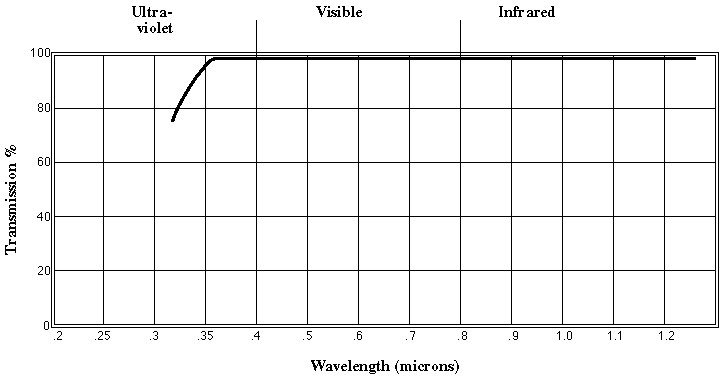    
|
|||
|
|||
Norland Optical Adhesive 63 ("NOA63") is a clear, colorless, liquid photopolymer that will cure when exposed to ultraviolet light. Since it is a one part system and 100% solids,it offers many advantages in bonding of optical elements where the bonding surface can be exposed to light. The use of NOA 63 eliminates premixing, drying or heat curing operations common to other optical adhesive systems. Curing time is remarkably fast, and is dependent upon the thickness applied and the amount of ultraviolet light energy available.
NOA 63 is recommended for the bonding of achromats, prisms and all other precision compound optics. The outstanding characteristics of the adhesive are its low fluorescence and its excellent transmission in the near UV range. After full cure, the adhesive has good transmission from 320 to 3,000 nanometers.
This adhesive is also suitable for bonding glass to metal. The high viscosity of NOA 63 allows it to be applied as a self-supporting drop or bead along the edge of a precision component to bond it to the substrate. The adhesive cures well in thick sections and has low shrinkage and a slight resiliency to minimize strain.
NOA 63 is cured by ultraviolet light with maximum absorption in the range of 350 to 380 nanometers. The recommended energy required for full cure is 4.5 Joules/sq. cm of long wavelength UV light.
| HAND HELD | MANUFACTURER | CURE AREA | APPROX. CURE TIME |
| Opticure LED 200 |
|
1/2 inch | 5-10 seconds at 1/2 inch |
| DESK TOP | MANUFACTURER | CURE AREA | APPROX. CURE TIME |
|
4 x 15 inches | 40 minutes at 6 inches |
In most optical applications, curing is done in two steps. First a short exposure, or precure, is used. This cures the adhesive enough to allow it to be handled without disturbing the alignment and keeps the number of alignment fixtures to a minimum. At this time, parts can be inspected and excess adhesive can be cleaned up with an acetone or alcohol moistened cloth. Any rejected pieces are most easily separated at this stage. Cure is completed by exposure for the remainder of the cure time.
The NOA bond can be separated in chlorinated solvent such as methylene chloride. The bonded area must be soaked in the solvent and normally will separate overnight if only precured. Longer times may be necessary depending upon the extent of the cure and the size of the bond area.
The NOA 63 can withstand temperatures of-15 to 60° C when used to bond glass optics. In some cases temperatures to 90° C are possible when the adhesive is used as a film or coating. The latter would depend upon the application.
| Solids | 100% |
| Viscosity at 25° C | 2000 cps |
| Refractive Index of Cured Polymer | 1.56 |
| Elongation at Failure | 6% |
| Modulus of Elasticity (psi) | 240,000 |
| Tensile Strength (psi) | 5,000 |
| Hardness - Shore D | 90 |
Shelf life of the liquid is a
minimum of 6 months
from the date of shipment, refer to the package label for the actual
expiration date, if stored in a cool (5-25° C), dark place in the
original container. If refrigerated,
allow the ahesive to come to room temperature prior to use.
Care should be taken in handling this material. The Material Safety Data Sheet should be read for this product as well as for any associated products such as alcohol, acetone or methylene chloride. Prolonged contact with skin should be avoided and affected areas should be thoroughly washed with copious amounts of soap and water. If the adhesive gets into eyes, flush with water for 15 minutes and seek medical attention. Use the material in a well ventilated area, otherwise a NIOSH approved organic vapor mask is recommended.

[Click Here To View MSDS Information]